Go Your Own Way
Fall 2023
Switch up your north-south drive with ghost towns and gorgeous scenery.
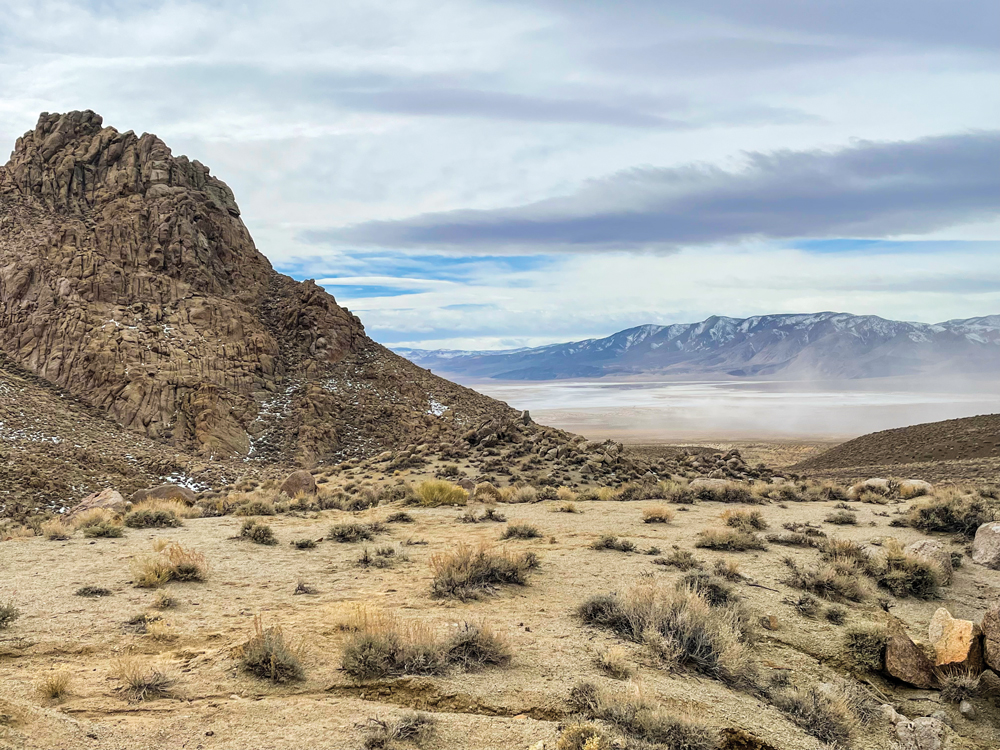
As the main road for travel between Reno and Las Vegas, U.S. Route 95 sees its fair share of traffic. Millions of motorists take this 400-mile journey each year, many of them doing it more times than they can count. If that sounds like you, mix things up on your next odyssey with a ghost-town packed alternate route. Without stops, this drive via State Routes 360, 264, and 266 will add only about 15 minutes to your total drive—but who are we kidding, you’ll be pulling over.

 BELLEVILLE
BELLEVILLE
You’ll spot Belleville on State Route 360, about 15 miles south of Mina. The ruins are located right off the road because in the late 1800s, this highway was a railroad, and Belleville was a station town. For the thriving boomtown of Candelaria—located 9 miles east—Belleville was a crucial logistical hub.
All water and goods bound for Candelaria were first unloaded in Belleville and then delivered by wagon. Candelaria even carted its silver ore to Belleville for milling and shipping. But Belleville was also the place folks visited to have fun. By all accounts, Candelaria was a windy and expensive dustbowl. When its residents needed to relax, they headed over to Belleville’s exciting night life. You might say it was one of the state’s first resort towns.
Belleville thrived into the 1880s, peaking at around 500 residents. Very little remains, however the foundation for one of the stamp mills can be seen from the highway. Another is located slightly up the hill.
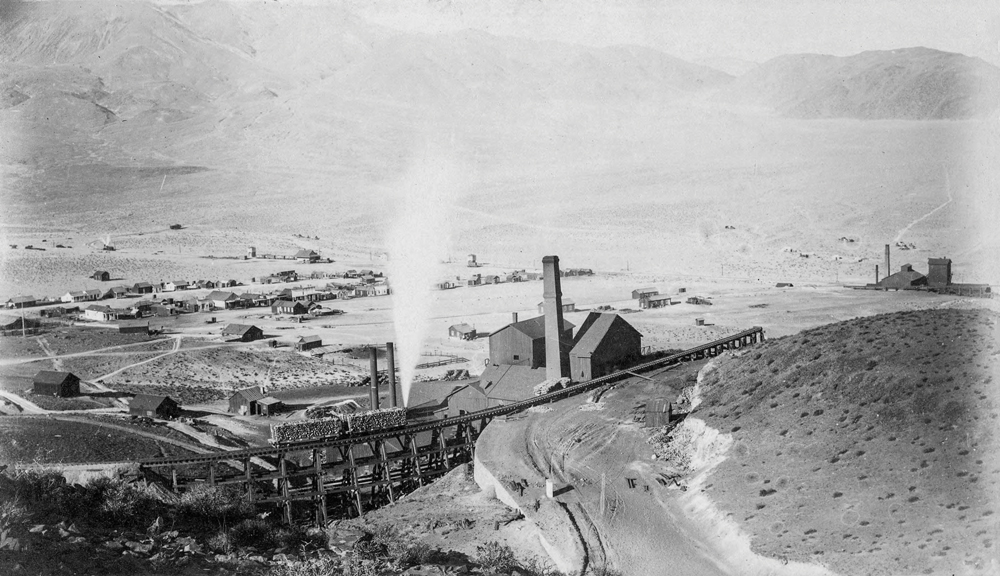
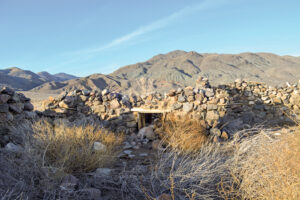 MARIETTA
MARIETTA
From Belleville, the bumpy drive to Marietta takes about 40 minutes. Shortly after turning onto dirt, you’ll be in the Marietta Wild Burro Range, a 66,500-acre tract of desert wilderness home to around 85 burros. Don’t forget your binoculars—there are plenty of excellent vantage points to do some spotting.
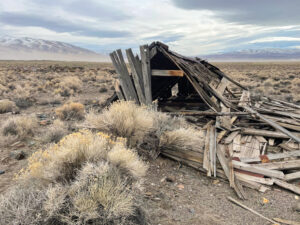 After winding down into an alkaline flat valley, you’ll be rewarded with a view of Boundary Peak—Nevada’s tallest mountain. The remains of Marietta are scattered along the north end of the valley. In contrast to many Nevada boomtowns, Marietta wasn’t in the business of mining gold or silver: Its wealth came from borax, a specialized salt that was used in cleaning, medicine, ceramics, and metallurgy.
After winding down into an alkaline flat valley, you’ll be rewarded with a view of Boundary Peak—Nevada’s tallest mountain. The remains of Marietta are scattered along the north end of the valley. In contrast to many Nevada boomtowns, Marietta wasn’t in the business of mining gold or silver: Its wealth came from borax, a specialized salt that was used in cleaning, medicine, ceramics, and metallurgy.
Borax deposits were discovered in 1877, and Marietta soon became a sizeable town of a few hundred residents. Its decline came in the 1890s after better borax deposits were found further south near Death Valley. Today, you’ll find a handful of standing structures in good condition and a half dozen foundations plus a cemetery.

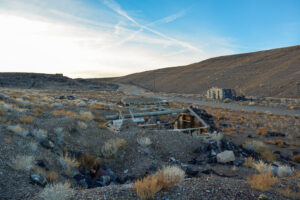 CANDELARIA
CANDELARIA
Candelaria is a 25-minute drive from Belleville, but you’ll spot mine entrances, rock cabins, and excavated hillsides long before reaching its decayed main street.
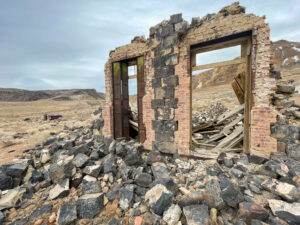 Silver mining began here in 1873. The lode proved rich, and by 1880, Candelaria was the largest community in Mineral County with 1,500 residents. During peak years, its busy downtown included a bank, a newspaper, luxury hotels, and a telegraph office.
Silver mining began here in 1873. The lode proved rich, and by 1880, Candelaria was the largest community in Mineral County with 1,500 residents. During peak years, its busy downtown included a bank, a newspaper, luxury hotels, and a telegraph office.
By 1884, legal disputes and a summer-long worker strike cut production in half. The town declined, then revived briefly in the 1890s before a national recession shut everything down again. Candelaria was likely always doomed to fail because it had no easy access to water. Even after a 27-mile pipeline was built in 1882, water was still prohibitively expensive. There was rarely enough for industrial use, and mills were forced to crush ore dry. Unfortunately, this technique creates a lot of dust, which made many workers very sick.
Smaller scale mining kept Candelaria alive up until the 1920s. In the mid-1930s, the post office closed, and the last residents departed. Today, few major structures survive, though a gated historic cemetery remains. Candelaria is nowhere near an empty patch, though. Equipment, debris, foundations, and crumbled structures are everywhere: One could easily spend a day wandering its hillsides.

Back Among the Living

Extend your travel with a stayover in this scenic village.
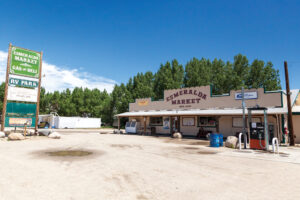 While on State Route 264—near the California border—you’ll come across the little town of Dyer (known locally as Fish Lake). This old ranch town is an excellent basecamp for OHV trails, horseback riding, and hiking. It’s also the only spot for many miles where you’ll find fuel, food, and lodging.
While on State Route 264—near the California border—you’ll come across the little town of Dyer (known locally as Fish Lake). This old ranch town is an excellent basecamp for OHV trails, horseback riding, and hiking. It’s also the only spot for many miles where you’ll find fuel, food, and lodging.
 We recommend you overnight at the Wagon Wheels RV Park, which offers hookups, tent camping, and four 120-year-old cabins that include a kitchenette.
We recommend you overnight at the Wagon Wheels RV Park, which offers hookups, tent camping, and four 120-year-old cabins that include a kitchenette.
The property is home to a well-curated outdoor museum that includes six historic buildings. If you’re looking to host a larger group, consider renting out one of the area’s four Airbnbs.
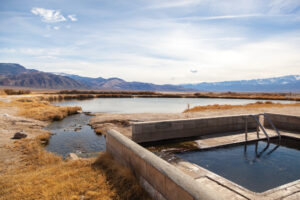 For snacks, sundries, and tasty sandwiches, visit the Esmeralda Market. For dinner, head to The Boonies, an old-fashioned saloon that features half of an antique car sticking out of the wall. You’ll find good fare here including chicken strips, salads, weekly specials, and 10 varieties of burgers.
For snacks, sundries, and tasty sandwiches, visit the Esmeralda Market. For dinner, head to The Boonies, an old-fashioned saloon that features half of an antique car sticking out of the wall. You’ll find good fare here including chicken strips, salads, weekly specials, and 10 varieties of burgers.
There is plenty to do and see around town. The trailhead for Boundary Peak is less than an hour from Dyer. If you’re looking to hit up a hot spring, check out the nearby Hot Box. For a gorgeous offroad drive, consider a visit to McAfee Canyon. If you’re seeking to explore some otherworldly landscape, take a trip to The Sump.
